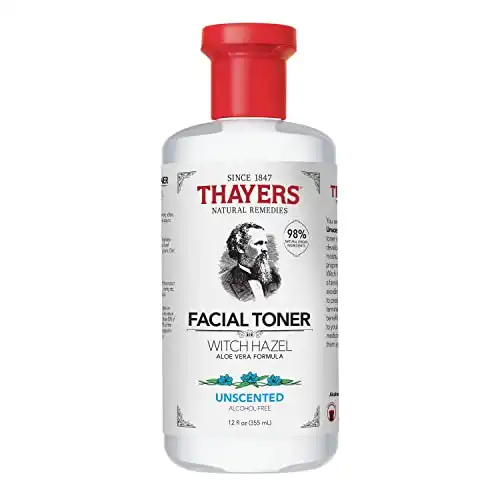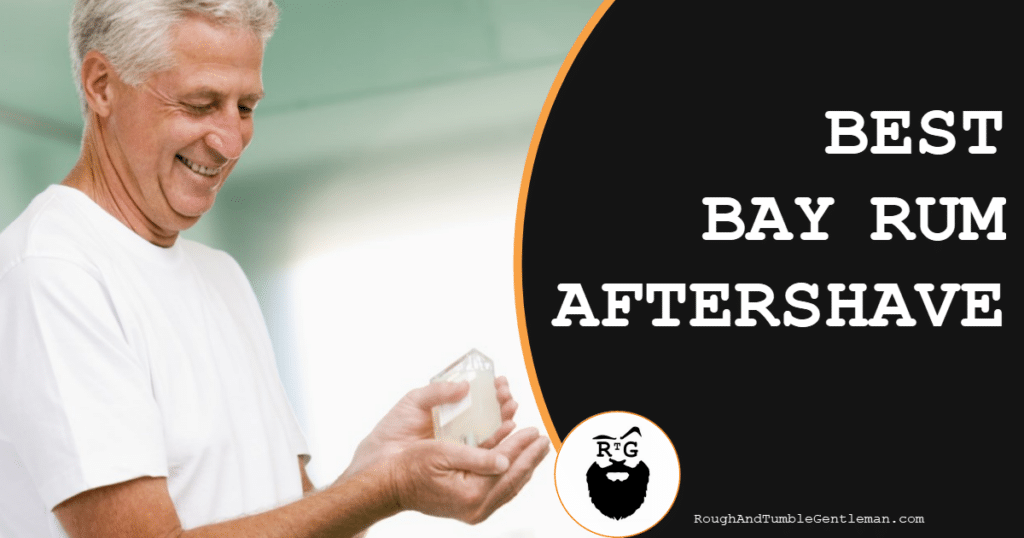Consistent shaving can really do a number on your face. By itself, it’s extremely drying and one slip of the hand can cause nasty scars. That’s why it’s so important to do things right, and that includes aftercare. Today, I’ll talk about nine great aftershave alternatives.
Without the proper shaving routine, your skin will be rough like sandpaper. You’re going to have problems if you don’t add any post-shave moisture.
Shaving sometimes gets a bad reputation. You have to worry about nicks, scratches, and irritation. However, when you do it right, shaving is a very effective exfoliant.
That means that it clears away dead skin giving your face an even surface.
As long as you use proper technique, maintain your tools, and use an aftershave or aftershave alternative, shaving can give you clearer and smoother skin than you’d have otherwise.
Guys with sensitive skin have a few more things to consider:
- If you have acne, it’s important to get it under control. It’s much easier to cut your face and leave rough looking scars when trying to shave around active pimples.
- The second is that all products should be as simple and natural as possible. The more ingredients there are in something, the more chance there is for a random fragrance or filler to cause an unexpected breakout.
- The last is that cutting yourself is an unpleasant but pretty common part of shaving. That’s why you should use an aftershave with some antibacterial power behind it.
List of Our Favorite Aftershave Alternatives
So let’s dive right into our full list of nine great aftershave alternatives.
Our Favorite Alternatives to Traditional Aftershave Include:
- Witch Hazel
- Potassium Alum
- Mineral Oil
- Apple Cider Vinegar
- Aloe Vera
- Essential Oils (certain ones)
- Cold Water
- Rosewater
- Beeswax
- Vegetable Glycerin
Now we’ll expand on each of these alternatives to aftershave and explain why they’re great (and provide tips for using them with great results).
Witch Hazel – It’s A Barber’s Favorite For A Reason
As we touched on earlier, it’s important to control acne if you shave. Having pimples on your face make you more likely to end up with nicks and cuts.
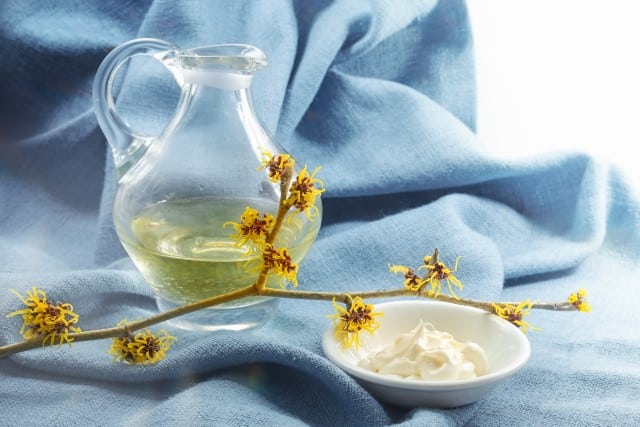
Keeping your skin pH and oil levels stable is an important part of preventing breakouts.
Unfortunately, shaving strips the skin of oil and alters its pH balance. Subjecting your skin to regular shaving means that a pimple or two is inevitable.
Luckily, witch hazel is just the thing you need to zap a zit fast.
Witch hazel has a number of medicinal uses. One of its major chemicals, called tannins, possesses powerful restorative qualities.
Tannins help to kill bacteria and calm inflammation. The fact that they fight inflammation is good for managing skin conditions such as psoriasis and acne.
We recommend that you spot treat active breakouts or apply a light layer for regular maintenance.
But while it has many benefits, use caution when you use witch hazel after shaving.
If you’re not careful, you could cause new irritation. In some cases, you could even end up with a light chemical burn.
Witch hazel also has a slight, but somewhat vinegar-like smell.
As long as you remember that you shouldn’t use witch hazel all the time or by itself, neither of these problems should be a big deal.
Potassium Alum – Who Knew Salt Made A Good Aftershave?
Potassium alum is a kind of salt that’s been used as a cosmetic for thousands of years. This one-ingredient-wonder disinfects, fights acne and scars, tones skin, and stops bleeding in a hurry.
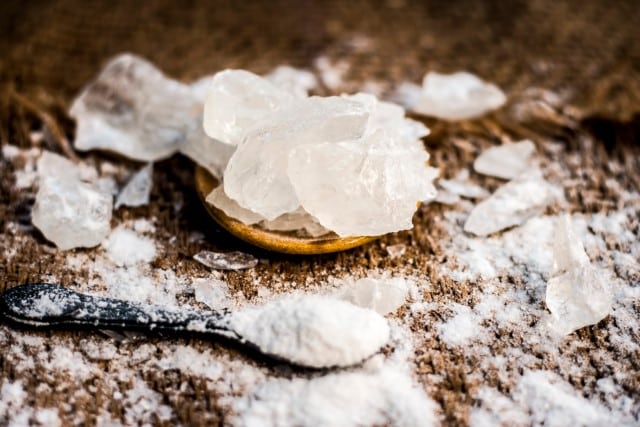
It’s a superb aftershave alternative for guys that like to keep it simple. However, it will dry out your skin, so you have to moisturize afterwards.
You can find potassium alum in block form. Wet the block, rub it on your face, wait 20 seconds, and rinse.
Be prepared for some stinging, though.
Remember to use a hydrating face cream after using potassium alum, though. If you don’t, you’ll have a dried out face.
Mineral Oil (not baby oil)
If you have sensitive skin, it’s best to stick to a simple routine. The products you use should have short ingredient lists, to cut down on the risk that they contain irritants.
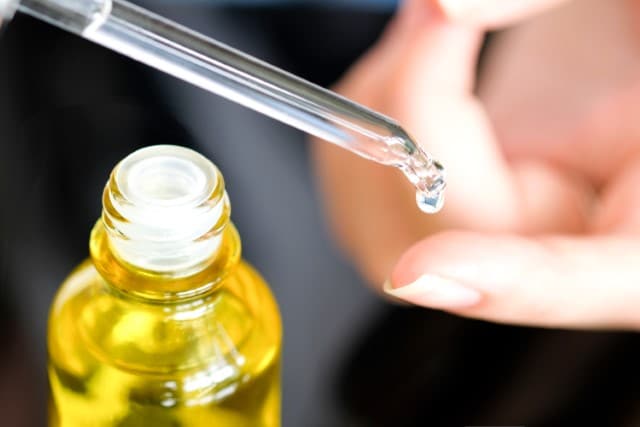
While witch hazel and potassium alum are great single-ingredient toners, finding simple ingredient moisturizers can be trickier.
Most are loaded with fillers, making it hard to identify a particular irritating ingredient.
That’s where plain old-fashioned mineral oil comes in. It’s a moisture-preserving, non-irritating aftershave alternative.
Avoid Baby Oil
Maybe you’re thinking that because baby oil contains mineral oil, that you can just go with that. But that’s not true.
Baby oil isn’t just pure mineral oil. It is thinner and it contains fragrance. The artificial fragrance it contains is likely to irritate your face, especially if you have sensitive skin.
The fragrance in baby oil can also cause problems like breakouts and itching.
That’s why we recommend you look for plain mineral oil instead.
You can use mineral oil for every step of the shaving process if your skin is really dry or sensitive.
Apply mineral oil thickly to use as a shaving cream, then rinse thoroughly and add a fresh layer. This will act as a
It’ll take some work to find the proper amount for you. Just note that mineral oil is super heavy, so less is more.
Apple Cider Vinegar – Smelly, But Pretty Good
Almost everybody has a bottle of apple cider vinegar hiding somewhere in their kitchen cabinet. Most of us won’t touch it for years at a time.

However, the well-informed few use the stuff for everything from cleaning tiles to treating scalp issues.
It even makes an extremely cheap, but effective, aftershave alternative.
ACV is a byproduct of fermented apples. This fermentation process creates acetic acid, the key ingredient in apple cider vinegar.
The acetic acid is a potent antibacterial and antifungal compound, making ACV good for treating beardruff (beard dandruff) or ringworm.
You might be thinking, “with all those benefits, why don’t more people use apple cider vinegar as their aftershave?”
Well, to be blunt, apple cider vinegar stinks.
One sniff and thoughts of DIYing an aftershave out of it will disappear fast. The smell can be covered up by dilution, but it’s not easy to hide all the way.
To use apple cider vinegar without wearing its smell all day, try adding peppermint oil or any other good beard oil that’s nice and pleasant.
It’s best to use a super filtered apple cider vinegar. That is because unfiltered or organic ACV usually comes with intact strands of protein called “the mother.”
While this isn’t necessarily a problem in itself, it’s kind of disgusting. You don’t want to have to deal with bits of protein in your aftershave.
It’s up to you, but we prefer the super filtered store brand stuff for a much nicer user experience.
Aloe Vera – Not Just For Burns
You’re probably familiar with the aloe gel that’s used for treating burns. It turns out that this stuff is terrific for treating all kinds of irritation.

It’s a particularly potent skin soother after a rough shave or particularly bad breakout. It’s also 98 percent water, making it a superior moisturizer.
How you get aloe vera depends on your preference. Buying a premade aftershave or toner is an option, but often there’s not that much real aloe vera in products marketed as such.
We recommend that when you buy aloe vera, you make sure it’s a simple, yellowish or clear gel that says “aloe barbadensis” or something similar as the first ingredient.
Maybe you thought that aloe vera gel should be green. After all, that is often what we see in drugstores.
So, you’ll probably be surprised to learn that that green color is artificial. Like artificial fragrance, artificial color can cause skin irritation and rashes.
If you’d like to, you could try growing your own aloe vera plant.
This is the cheapest option by far, but it isn’t for everyone.
The aloe you’ll get from the leaves is a raw plant material. This means that it will go bad much faster than anything else on this list.
It also doesn’t mix well with oils in its raw state and can go rancid, ruining the oils it’s been mixed with.
Once you cut open that aloe leaf, you’ve made a commitment to use it quickly. Aloe straight from the plant also has a sticky, tacky texture. It works well but it doesn’t feel the nicest to use.
Aloe vera is a powerful medicinal plant. Even though it’s generally mild, you shouldn’t overuse it.
In fact, if you use it daily, you might end up with some irritation.
We recommend using it either every few days or just when your skin needs some extra help.
Essential Oils – There’s One For Everything
Essential oils are popular for skincare – just ask any of the ladies pushing them in your social media feed every single day.

There are dozens of these oils available, each with a different use. We could spend this entire post singing each one’s praises, but we’re just going to highlight our favorite three.
- Tea tree oil is a winner. It has everything you could ask for in shaving aftercare. It’s antibacterial, wound healing, anti-itching, and it even helps normalize oil production. It definitely has a medicinal smell though, so it’s best combined with a nicer smelling oil. But as we’ve said, sensitive skin does not jive well with artificial fragrances.
- If you have sensitive skin but still want to smell great, peppermint oil has a scent that smells nice on anyone of any age. Aside from that, it’s a potent anti-fungal and anti-itching agent.
- Chamomile oil is similar to peppermint, with a weaker smell and added wound healing capabilities.
Whatever oil you choose, you don’t want to use any oils without diluting them first.
Look for cosmetic grade essential oils in dark bottles with only one or two ingredients on the label. You’ll want to dissolve a few drops into something plain like mineral oil or vegetable glycerin to reap the benefits without it being too overpowering.
It cannot be overstated how strong essential oils can be. Don’t go overboard with application, and make sure that you’ve diluted them correctly before use.
Guys with sensitive skin will want to patch test any new oil on their wrist or inner elbow before they put it on their face.
Cold Water – Does Not Replace An Aftershave
We love shaving with cold water, and cold water is actually a pretty popular aftershave. You can find cold tap water in any bathroom (did we really need to say this, fellas?), and it’s not like it’ll cause your skin to break out.
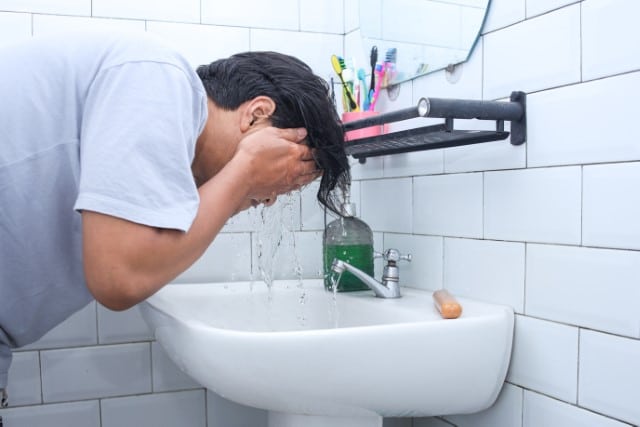
However, cold water is not enough by itself to rehydrate the skin after shaving. It may make your skin appear moisturized for a little while, but when it dries it will leave your skin drier than it was before.
Cold water’s main benefit comes from its low temperature. Coldness reduces redness and makes skin appear more even and less oily.
But you can get this benefit from any aftershave just by storing it in the fridge.
We aren’t saying that cold water is bad. It just isn’t a good aftershave.
Warm water strips oils, whereas cold water does not. Shaving or washing with cold water helps to combat dry skin by allowing the skin to retain more of its moisture.
Once you’ve rinsed your face with cold water, apply a moisturizing product.
Rosewater – For When You’re Feeling Fancy
Rosewater is made by steeping rose petals in distilled water, kind of like tea. The short ingredient list and simple process means that you can DIY your own rosewater if you’re so inclined.
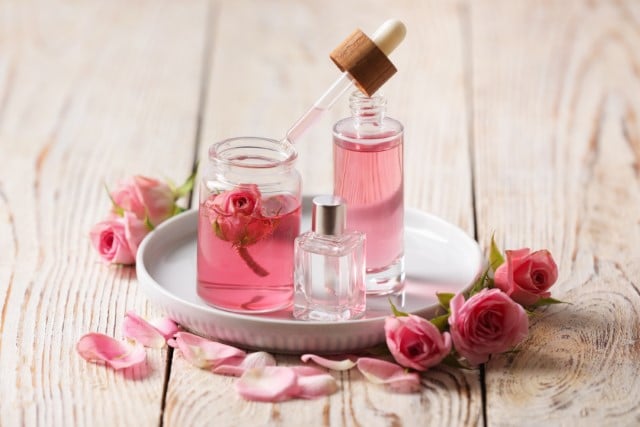
You’ll probably save some money, if you do, as a small bottle of premade rosewater can go for 15 USD or more.
However, the right premade brand of rosewater will likely be purer and therefore more effective than what your average joe can whip up at home.
Buying the right rosewater isn’t hard but there are some things to keep in mind.
- One is that pure rosewater isn’t pink. It’s clear. The pink tint that a lot of rosewater products have is from artificial additives.
- Another is that pure rosewater has a mild smell that isn’t perfume-y at all. If your rosewater has a heady, cloying aroma then it’s not the real deal. Look for something like “rose distillate” or “rose damascena” as the first ingredient to make sure you’re not buying something that’s too heavily diluted.
Rosewater has all the qualities that you’d look for in an aftershave toner.
It’s antibacterial, has a nice smell, fights irritation, and even reduces redness.
While not hydrating, it also doesn’t dry out your skin the same way something like witch hazel can.
Rosewater is a great choice of aftershave for guys with sensitive skin.
Beeswax – Amazing, Just Don’t Google Where it Comes From
Beeswax is a primary ingredient in most good balms (including the best beard balms).
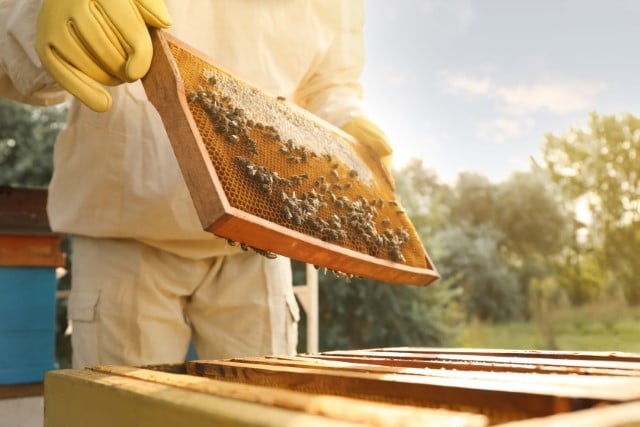
Like mineral oil, it creates a protective barrier that locks in moisture and creates a layer over the skin.
Unlike mineral oil, it comes with nourishing compounds of its own, such as vitamin A. As a natural product, it causes little to no irritation beyond possibly clogging pores if you use too much.
Beeswax is on the pricier side. It takes about 8 pounds of honey to create a 1 pound brick of beeswax.
But if you can handle the cost, this is one of the most moisturizing natural aftershaves that you can buy.
Beeswax comes as a yellow or off-white block. You can use the block without doing anything extra to it.
Just rub it on like chapstick … but for your whole face.
However, we think it works best as a vehicle for other things like essential oils. Just melt the beeswax in the microwave and stir in the additives of your choice, then apply.
Vegetable Glycerin – A Must Have For DIYers
Vegetable glycerin sounds like something out of a science experiment, but it’s really nothing mysterious. It’s a slightly sticky fluid made from plant oils.
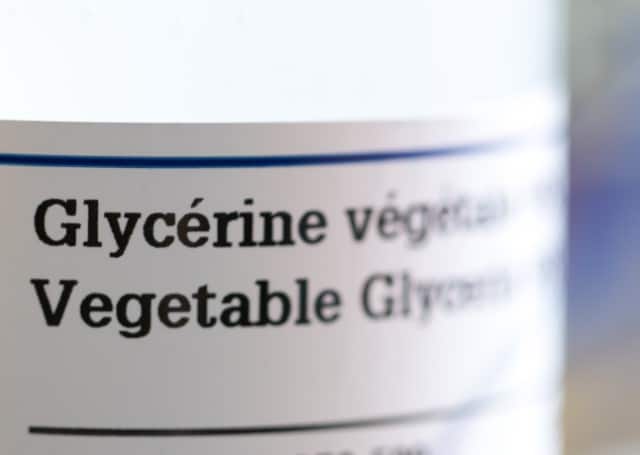
It’s actually a very natural, non-irritating substance.
Like beeswax, you’ll find vegetable glycerin in the ingredient list of most of your favorite products. Manufacturers love it because its shelf stable and we love it as an aftershave base.
It’s one of the best moisture delivering cosmetics you can find while being cheap enough to allow for trial and error. One of our favorite mixes is a two ingredient aftershave using vegetable glycerin and some sort of toner, like witch hazel.
Vegetable glycerin can be purchased in big containers from online retailers. That’s good for us, as it’s best used in large quantities to carry something more powerful like an essential oil.
You can totally use vegetable glycerin by itself and it will work just fine. We don’t use it that way, though, just because mixing something with it is more fun.
And Finally, Something You Should Never Use as an Aftershave … Rubbing Alcohol
Rubbing alcohol is a terrible aftershave.

People use it because the burn makes it feel like it’s doing something. But a stinging face does not mean that this, or any other product, is working well.
Get that kid from Home Alone out of your mind.
What you’re feeling when you use an aftershave with rubbing alcohol is alcohol interfering with the nerves in your skin that sense hot and cold. The tightness that follows is the feeling of your face being bone dry and totally unprotected from the elements.
Alcohol should only really be used to disinfect cuts that need real attention. If you’re looking to treat irritation, witch hazel is a much less aggressive aftershave alternative with a mountain of other benefits.
Choosing the Best Aftershave Alternative for You
There are lots of things to consider when choosing an aftershave.

- Oilier skinned guys should stick to toners like witch hazel followed up by or combined with moisturizing options like vegetable glycerin.
- If your skin is dry, try shaving with cold water and following it up with a DIY aftershave beeswax mix.
- If you’re trying to have the simplest routine possible, mineral oil is one ingredient that can do everything. The possibilities are immense.
At the end of the day, you’re the only one who can decide on which aftershave alternative suits you best.
So, try some of the alternative aftershave options on our list, and see what works. Make sure that you know your skin type, so you can choose the most suitable options.
Michael Morris is the head writer here at Rough and Tumble Gentleman. He's got a ducktail beard and loves Brazilian jiu-jitsu. He's married to the woman of his dreams and lives in Brooklyn, NY.


